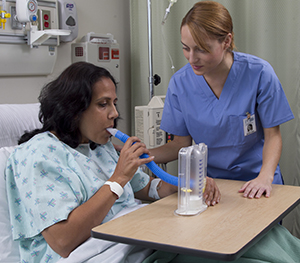Thoracotomy: Your Hospital Recovery
A thoracotomy is surgery to open the chest wall. It may be done to treat a collapsed lung or to remove a tumor or mass from within the chest wall. Your hospital stay after a thoracotomy may be 3 to 4 days. Ask your care team how long you may need to stay in the hospital.
Right after surgery
You will wake up in a special monitoring unit. When you first wake up from the anesthesia, you may feel groggy, thirsty, or cold. If the breathing tube given to you during surgery remains in place, you won’t be able to talk. Monitors record your heartbeat and how much oxygen is in your blood.
Flexible tubes in your chest drain air, blood, and fluid. An I.V. (intravenous) line placed in your arm, hand, or neck gives you fluid and medicines.
A tube may be placed in your bladder to drain your urine. These tubes are usually removed when they are no longer needed, before you go home.
You may spend one or more days in this unit before you’re moved to your hospital room.
Managing your pain
As soon as you’re able, a nurse or physical therapist (PT) will help you begin to move around. This is to help improve your muscle strength and blood flow. You’ll be asked to sit up and walk. You can get pain medicines to help control pain as you move. A nurse may give you these medicines. Or you may have a special pump called a PCA (patient-controlled analgesia). This lets you give yourself pain medicine as you need it.
You may have had an epidural before surgery. If so, it may stay in place for a few days to give you more pain relief.
Respiratory therapy
Soon after surgery, a nurse or respiratory therapist will teach you breathing exercises. These help keep your lungs clear. They also make your breathing muscles stronger and help prevent problems such as pneumonia. The exercises include incentive spirometry. You’ll put your mouth around a plastic device and breathe in as much air as you can. You will also be taught coughing exercises, deep-breathing exercises, and other breathing exercises to do on your own.

Range-of-motion exercises
A nurse or PT may teach you range-of-motion exercises. These exercises help stretch and strengthen the muscles on the side where you had surgery. They can help keep your shoulder moving freely. You may also be taught exercises to do at home as you heal.
Going home
Before you go home, your healthcare provider will review the results of your surgery with you. They can also tell you what to expect as you recover. If you need more treatment, you and your healthcare provider will discuss this. You will also review the next stage of your treatment plan and schedule follow-up visits. You will be given a list and prescriptions for your medicines after the surgery. These are often different from the medicines before the surgery. When you’re ready to go home, have a family member or friend drive you.